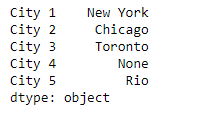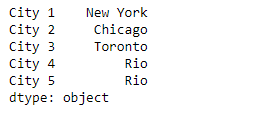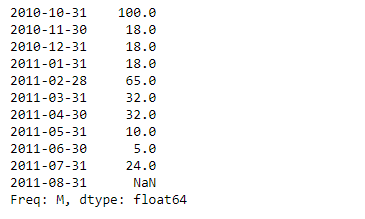Python Pandas Series.between_time()
Pandas系列是一个带有轴标签的一维ndarray。标签不需要是唯一的,但必须是一个可散列的类型。该对象支持基于整数和标签的索引,并提供了大量的方法来执行涉及索引的操作。
Pandas Series.between_time()函数选择一天中特定时间之间的值(例如,9:00-9:30 AM)。通过设置start_time比end_time晚,你可以得到不在这两个时间之间的时间。
语法: Series.between_time(start_time, end_time, include_start=True, include_end=True, axis=None)
参数:
start_time : datetime.time 或字符串
end_time : datetime.time 或字符串
include_start : boolean, default true
include_end : boolean, default true
axis: {0或’索引’,1或’列’},默认0
返回: values_between_time : 与调用者类型相同
例子#1:使用Series.between_time()函数来返回位于给定时间段内的数值。
# importing pandas as pd
import pandas as pd
# Creating the Series
sr = pd.Series([11, 21, 8, 18, 65, 18, 32, 10, 5, 32, None])
# Create the Index
index_ = pd.date_range('2010-10-09 08:45', periods = 11, freq ='H')
# set the index
sr.index = index_
# Print the series
print(sr)
输出 :

现在我们将使用Series.between_time()函数来返回位于给定时间段的数值。
# return values between the passed time duration
result = sr.between_time(start_time = '10:45', end_time = '15:45')
# Print the result
print(result)
输出 :

正如我们在输出中看到的,Series.between_time()函数已经成功地返回了位于给定时间段内的数值。
示例#2 :使用Series.between_time()函数来返回位于给定时间段内的值。跳过对应于开始和结束时间的值。
# importing pandas as pd
import pandas as pd
# Creating the Series
sr = pd.Series([11, 21, 8, 18, 65, 18, 32, 10, 5, 32, None])
# Create the Index
index_ = pd.date_range('2010-10-09 08:45', periods = 11, freq ='H')
# set the index
sr.index = index_
# Print the series
print(sr)
输出 :

现在我们将使用Series.between_time()函数来返回位于给定时间段内的数值。跳过对应于开始和结束时间的值。
# return values between the passed time duration
# skip the start and end time
result = sr.between_time(start_time = '10:45', end_time = '15:45',
include_start = False, include_end = False)
# Print the result
print(result)
输出 :

正如我们在输出中看到的,Series.between_time()函数已经成功地返回了位于给定时间段内的数值。请注意,对应于开始和结束时间的值没有被包括在内。
 极客教程
极客教程